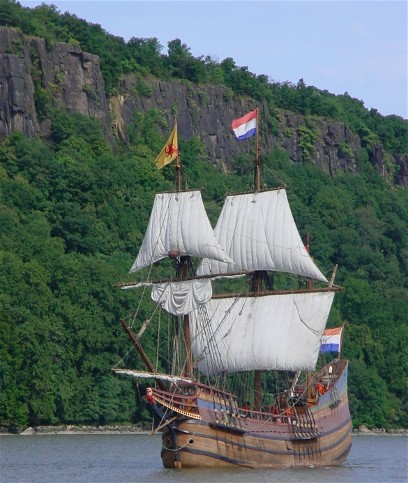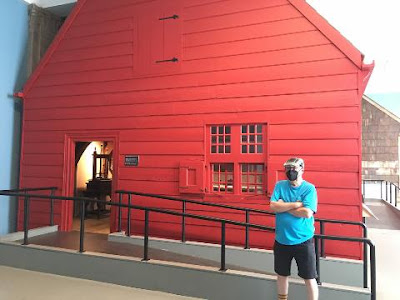These ancestors of ours were almost certainly involved in early representative government in a colony that early-on was characterized somewhat by tolerance and diversity, at a time when New England colonies were largely under the Puritans. “Dutch tolerance was indeed renowned throughout Europe” (pg. 274, Shorto). “Religious bigotry was a mainstay of society. The four New England colonies to the north were founded on it”. The Dutch were supposed to be an exception, but “the blanket of tolerance got a bit tattered on the transatlantic voyage”. African enslaved persons were in New Netherland, but had some legal rights, including the right to sue Europeans. Small consolation.
Sir Winston Churchill (“A History of the English Speaking Peoples: The New World”) dubbed Roger Williams of Rhode Island as “America’s First Political Thinker”, an advocate of separation of church and state. Williams may have arrived in New England about the same time as Phoebe Sayles (Gary’s 9th great grandmother), who reportedly sailed in one of Winthrop’s ships to New England before she and her father moved to New Netherland and altered their names to Dutch equivalents. Femmetje “Phoebe” Sayles Van Middleswaert & Sarah Rapalje Bogaert (both were Gary’s 9th great grandmothers) later became in-laws when their kids married, & were both buried in the same Dutch Reformed cemetery at Flatbush Long Island, viewed in June 2023. Phoebe & Sarah were ancestors of Gary’s 6th great grandmother Marytje Brokaw Van Voorhees (b. 1721), who was only 1 generation removed from where AncestryDNA’s Thru Lines analyses start connecting Gary’s autosomal DNA with cousins with this ancestry.
In 1609, Englishman Henry Hudson had explored the river now bearing his name, up to a future fur trading station at Fort Nassau. Hudson was the subject of a blog entry by Gary’s onetime associate, the Frieslander Hans Zijlstra, whose yDNA is a match with several of our Schenck cousins and with others from the far north Netherlands. Fort Orange (much later called Albany) became the first settlement of the Dutch colony New Netherland, & our Rapalje ancestors arrived with other Walloons (French speakers from current Belgium) on the very first immigrant ship, in 1624. This Dutch colony landed near the Dutch trading post of Fort Nassau in 1614, which pre-dated the 1620 Mayflower voyage, but did not predate the founding of Jamestown (associated with our Tucker and Parham ancestries). Joris’ & Catalina’s daughter Sarah Rapalje (b. 1625; Gary’s 9th great grandmother) was reportedly the first European baby born in New Netherland. She may currently have in excess of one million descendants. Joris “George” Rapalje figured prominently in New Netherland history, first at Ft. Orange, & then at Manhattan. See https://history.nycourts.gov/figure/joris-de-rapelje/ Prior to the 1636 attack by the Mohawks, 9th great granny Catrina Trico Rapalje had called the local Indians “Quiet as lambs”.
In 1636, following the murder of the Commissar (Commander) of Fort Orange by the Mohawks, Director Pieter Minuit ordered all the colonists in the outlying settlements to move to Manhattan. Joris Jansen de Rapalje set up an inn (& tavern) on Pearl Street, adjoining the old Fort. He was also a boatswain, involved in the capture of ships for prize.
On June 16, 1637, Joris de Rapalje purchased a 335-acre bowery (farm) near Wallabout in Brooklyn from the Native Americans. The estate included a considerable waterfront on the Bay, and lay along the stream known by its Indian name of Rinnegakonck.” Joris later lived on Long Island, was on a 12-man council & was a magistrate of Brooklyn. More on Rapalje:
https://sites.google.com/site/mcfarlandbatesfamilytrees/home/family-tree-of-arthur-glenn-mcfarland/smith-family-line/fulkerson-family-line/rapalje-family-line
By the late 1640s, New Amsterdam was becoming a hub of North American shipping. Adrian Van Der Donck organized the businessmen who made the port function. He organized a new political party, along with his associate, trader Jacob Couwenhoven (Gary’s 9th great granduncle), & others (pg. 197, Shorto).
See https://en.wikipedia.org/wiki/Adriaen_van_der_Donck for an account of Van Der Donck’s “Description of New Netherland”.
Thomas O'Donnell wrote: “Had he written in English rather than Dutch, his ‘Description’ would certainly have won from posterity the same kind, if not the same amount, of veneration that has been bestowed on Bradford's ‘Of Plymouth Plantation’. As it turned out, Van der Donck's book was written, published, widely read, put aside, and, alas, almost forgotten long before Bradford's book was published at all.
Though the English eventually took over the colony, the city of New Amsterdam retained the municipal charter van der Donck had lobbied for, including uniquely Dutch features, such as a guarantee of free trade.
In his 2004 work ‘The Island at the Center of the World’, the New York Times contributing writer Russell Shorto wrote that van der Donck's character and actions were important to the development of the American spirit and he labeled Donck as a ‘forgotten American patriot’."
In 1625 at Fort Orange, our Rapalje ancestors would have had close contact with the Mohawk tribe of the Iroquois Confederacy (Seneca, Cayuga, Oneida, Onondaga, & Mohawk; Tuscarora were added in 1722), and with the Mohicans. The Iroquois Constitution has in common, in part, with the US Constitution: A system of government that divides power among different branches; provisions for the protection of individual rights; & impeachment (a power of Iroquois women). Provisions of this Iroquois constitution were known to framers of the US Constitution. See the reference to the 1751 letter by Benjamin Franklin at https://www.history.com/news/iroquois-confederacy-influence-us-constitution
When the English seized New Netherland, the Dutch didn’t just go away. Some of our Dutch kin were still at Flatbush when that village served as a staging area for the 1776 British & Hessian assault on the Patriot forces at Brooklyn Heights, the largest battle of the Revolutionary War. The Green-Wood Cemetery at the Brooklyn Heights picturesque location was visited by Gary and friends in June 2023. A local history of 1776 was written about by Gertrude Phebe Lefferts Vanderbilt (b. 1824), Gary’s 3rd cousin, 5 times removed. Gertrude’s husband’s immigrating Van Der Bilt ancestor was an indentured servant to our Van Couwenhoven kin. The Vanderbilts prospered, no doubt as a result, in part, of Van Couwenhoven (Conover) tutelage. That’s my story and I’m sticking to it.
This Half Moon (Halve Maen) 1989 replica (made in Albany) is sailing up the Hudson River at The Palisades. Half Moon was the ship of Englishman Henry Hudson in the Dutch employ; in 1609 he went up the river as far as the rapids, where the Dutch later established a fur trading post, then a colony of settlers, our Rapalje & Trico kin being on the very first ship of settlers in 1624. This blog covers our Rapalje at Ft. Orange/Albany.
I think that I have seen this very Half Moon ship replica in Hoorn, but I can't recall when (I might have a clue on that, but need to do some research in old trip notes). According to Wikipedia, this ship is now at Volendam North Holland.





















